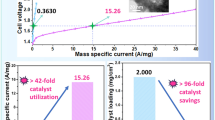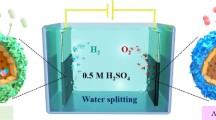Abstract
Amorphous iridium oxides (IrOx) are highly active for oxygen evolution reaction (OER) in acid media; however, it is generally unstable compared with commercial IrO2. Recently, many non-noble metal-iridium mixed oxides are prepared for catalyzing OER efficiently. Herein, we report a cubic fluorite-type praseodymium iridium oxide with the surface of IrOx (IrOx/Pr3IrO7) that shows the improved activity and stability in 0.1 mol L−1 HClO4 solution, characterized by an overpotential of 305 mV at the benchmark of 10 mA cm−2 and a small Tafel slope of 37 mV dec−1, indicating a fast reaction kinetics and a competitive activity compared with the benchmark IrO2 and most reported electrocatalysts. The initial potential increases by less than 0.07 V after continuous OER testing over 60,000 s. In contrast, IrO2 becomes nearly inactive for the OER within 20,000 s. Density functional theory calculations uncover that the optimal energy level path follows lattice oxygen mechanism (LOM). This work enlarges the family of the IrOx-type OER electrocatalyst in acid media.

摘要
非晶态铱氧化物(IrOx)在酸性介质中具有高的电催化析氧反 应(OER)活性, 但其稳定性不如商业IrO2. 近年来, 多种非贵金属-铱 混合氧化物展现出高效催化析氧反应的性能. 本文报道了一种含 IrOx高活性表面层的立方萤石结构镨铱氧化物(Pr3IrO7)催化剂. 该 催化剂在0.1 mol L−1 HClO4溶液中, 表现出高的析氧反应催化活性 和良好的稳定性, 优于商业IrO2和目前报道的大多数催化剂. 在电 流密度为10 mA cm−2时, 该催化剂的过电位为305 mV, 并具有低的 Tafel斜率, 约为37 mV dec−1, 表明该催化剂具有更快的反应动力 学. 在持续60000 s的稳定性测试后, 该催化剂的初始电位仅增加了 0.07 V, 而IrO2只经过20000 s测试就几乎丧失活性. 密度泛函理论 计算表明, IrOx/Pr3IrO7催化析氧反应遵循晶格氧机理(LOM). 这项 工作拓展了IrOx型酸性OER电催化剂的种类.
Similar content being viewed by others
References
Seh ZW, Kibsgaard J, Dickens CF, et al. Combining theory and experiment in electrocatalysis: Insights into materials design. Science, 2017, 355: eaad4998
Lettenmeier P, Majchel J, Wang L, et al. Highly active nano-sized iridium catalysts: synthesis and operando spectroscopy in a proton exchange membrane electrolyzer. Chem Sci, 2018, 9: 3570–3579
Liu Y, Li X, Zhang Q, et al. A general route to prepare low-ruthenium-content bimetallic electrocatalysts for pH-universal hydrogen evolution reaction by using carbon quantum dots. Angew Chem Int Ed, 2020, 59: 1718–1726
Song H, Li Y, Shang L, et al. Designed controllable nitrogen-doped carbon-dots-loaded MoP nanoparticles for boosting hydrogen evolution reaction in alkaline medium. Nano Energy, 2020, 72: 104730
Li W, Zhao Y, Liu Y, et al. Exploiting Ru-induced lattice strain in CoRu nanoalloys for robust bifunctional hydrogen production. Angew Chem Int Ed, 2020, 60: anie.202013985
Song H, Cheng Y, Li B, et al. Carbon dots and RuP2 nanohybrid as an efficient bifunctional catalyst for electrochemical hydrogen evolution reaction and hydrolysis of ammonia borane. ACS Sustain Chem Eng, 2020, 8: 3995–4002
Pi Y, Zhang N, Guo S, et al. Ultrathin laminar Ir superstructure as highly efficient oxygen evolution electrocatalyst in broad pH range. Nano Lett, 2016, 16: 4424–4430
Faustini M, Giraud M, Jones D, et al. Hierarchically structured ultraporous iridium-ased materials: A novel catalyst architecture for proton exchange membrane water electrolyzers. Adv Energy Mater, 2019, 9: 1802136
Nong HN, Reier T, Oh HS, et al. A unique oxygen ligand environment facilitates water oxidation in hole-doped IrNiOx core-shell electrocatalysts. Nat Catal, 2018, 1: 841–851
Reier T, Pawolek Z, Cherevko S, et al. Molecular insight in structure and activity of highly efficient, low-Ir Ir-Ni oxide catalysts for electrochemical water splitting (OER). J Am Chem Soc, 2015, 137: 13031–13040
Nong HN, Oh HS, Reier T, et al. Oxide-supported IrNiOx core-shell particles as efficient, cost-effective, and stable catalysts for electrochemical water splitting. Angew Chem Int Ed, 2015, 54: 2975–2979
Seitz LC, Dickens CF, Nishio K, et al. A highly active and stable IrOx/SrIrO3 catalyst for the oxygen evolution reaction. Science, 2016, 353: 1011–1014
Diaz-Morales O, Raaijman S, Kortlever R, et al. Iridium-based double perovskites for efficient water oxidation in acid media. Nat Commun, 2016, 7: 12363
Sun W, Liu JY, Gong XQ, et al. OER activity manipulated by IrO6 coordination geometry: An insight from pyrochlore iridates. Sci Rep, 2016, 6: 38429
Lebedev D, Povia M, Waltar K, et al. Highly active and stable iridium pyrochlores for oxygen evolution reaction. Chem Mater, 2017, 29: 5182–5191
Grimaud A, Demortière A, Saubanère M, et al. Activation of surface oxygen sites on an iridium-based model catalyst for the oxygen evolution reaction. Nat Energy, 2016, 2: 16189
Rong X, Parolin J, Kolpak AM. A fundamental relationship between reaction mechanism and stability in metal oxide catalysts for oxygen evolution. ACS Catal, 2016, 6: 1153–1158
Binninger T, Mohamed R, Waltar K, et al. Thermodynamic explanation of the universal correlation between oxygen evolution activity and corrosion of oxide catalysts. Sci Rep, 2015, 5: 12167
Geiger S, Kasian O, Ledendecker M, et al. The stability number as a metric for electrocatalyst stability benchmarking. Nat Catal, 2018, 1: 508–515
Nishimine H, Doi Y, Hinatsu Y, et al. Phase transition of Ln3IrO7 (Ln=Pr, Nd, Sm, Eu) and its low-temperature structure. J Ceram Soc Jpn, 2007, 115: 577–581
Severance RC, Fox AH, Mugavero Iii SJ, et al. Synthesis and crystal structures of two polymorphs of trilanthanum iridium septaoxide (La3IrO7). J Chem Crystlogr, 2010, 41: 496–501
Wang C, Zheng L, Chang R, et al. Palladium-cobalt nanowires decorated with jagged appearance for efficient methanol electro-oxidation. ACS Appl Mater Interfaces, 2018, 10: 29965–29971
Yao Y, Gu XK, He D, et al. Engineering the electronic structure of submonolayer Pt on intermetallic Pd3Pb via charge transfer boosts the hydrogen evolution reaction. J Am Chem Soc, 2019, 141: 19964–19968
Ding J, Yang S. Isolation and characterization of Pr@C82 and Pr2@C80. J Am Chem Soc, 1996, 118: 11254–11257
Chen Y, Li H, Wang J, et al. Exceptionally active iridium evolved from a pseudo-cubic perovskite for oxygen evolution in acid. Nat Commun, 2019, 10: 572
Fichtner J, Garlyyev B, Watzele S, et al. Top-down synthesis of nanostructured platinum-lanthanide alloy oxygen reduction reaction catalysts: PtxPr/C as an example. ACS Appl Mater Interfaces, 2019, 11: 5129–5135
Smith RDL, Sporinova B, Fagan RD, et al. Facile photochemical preparation of amorphous iridium oxide films for water oxidation catalysis. Chem Mater, 2014, 26: 1654–1659
Spöri C, Briois P, Nong HN, et al. Experimental activity descriptors for iridium-based catalysts for the electrochemical oxygen evolution reaction (OER). ACS Catal, 2019, 9: 6653–6663
Meng G, Sun W, Mon AA, et al. Strain regulation to optimize the acidic water oxidation performance of atomic-layer IrOx. Adv Mater, 2019, 31: 1903616
Oh HS, Nong HN, Reier T, et al. Electrochemical catalyst-support effects and their stabilizing role for IrOx nanoparticle catalysts during the oxygen evolution reaction. J Am Chem Soc, 2016, 138: 12552–12563
Choy JH, Kim DK, Hwang SH, et al. XANES and EXAFS studies on the Ir-O bond covalency in ionic iridium perovskites. J Am Chem Soc, 1995, 117: 8557–8566
Lin B N, Lin Y X, Hsu Y Y, et al. Anomalous Pr ordering, Pr L3-edge and Cu K-edge XANES studies for the insulating PrBa2Cu3-O7−y system. J Low Temperature Phys, 2003, 131: 803–807
Miao X, Zhang L, Wu L, et al. Quadruple perovskite ruthenate as a highly efficient catalyst for acidic water oxidation. Nat Commun, 2019, 10: 3809
Kuznetsov DA, Naeem MA, Kumar PV, et al. Tailoring lattice oxygen binding in ruthenium pyrochlores to enhance oxygen evolution activity. J Am Chem Soc, 2020, 142: 7883–7888
Sun Y, Liao H, Wang J, et al. Covalency competition dominates the water oxidation structure-activity relationship on spinel oxides. Nat Catal, 2020, 3: 554–563
Acknowledgements
This work was supported by Taishan Scholar Program of Shandong Province, China (ts201712045), Shandong Provincial Key Research and Development Program (SPKR&DP, 2019GGX102069), the Natural Science Foundation of Shandong Province of China (ZR2018BB008), and the Doctoral Found of Qingdao University of Science and Technology (0100229001, 010029081, 010029075).
Author information
Authors and Affiliations
Contributions
Liu X proposed the research ideas and designed the experiments. Qin Q and Liu X wrote the manuscript and performed the analysis. Wang Y, Liu H, Zhang L, Wei T, and Li H carried out the synthetic, electrochemical experiments and physical characterizations. Liu S carried out the DFT calculations. All the authors participated in this research project.
Corresponding authors
Additional information
Conflict of interest
The authors declare that they have no conflict of interest.
Yimeng Wang is currently studying for his Master degree under the supervision of Prof. Xien Liu at Qingdao University of Science and Technology. At present, his research focuses on the synthesis of metal-doped iridium-based oxide and electrocatalytic oxygen evolution performance in acidic media.
Shangguo Liu received his PhD degree from Beijing University of Chemical Technology in 2019. And then, He joined the College of Chemical Engineering, Qingdao University of Science and Technology. His research interests focus on exploring chemical and physical properties of materials by theoretical and computational tools.
Qing Qin received her PhD degree from Nankai University in 2017. Now she is a professor of Qingdao University of Science and Technology. Her current research interests focus on the design and synthesis of noble metal- and non-noble metal-based electrocatalysts for overall water splitting and Zn-air batteries.
Xien Liu received his PhD degree from Dalian University of Technology. He is currently a professor of Qingdao University of Science and Technology. His research interests focus on the design of electrocatalysts for electrochemical energy conversion and storage devices.
Rights and permissions
About this article
Cite this article
Wang, Y., Liu, S., Qin, Q. et al. Praseodymium iridium oxide as a competitive electrocatalyst for oxygen evolution reaction in acid media. Sci. China Mater. 64, 2193–2201 (2021). https://doi.org/10.1007/s40843-020-1598-5
Received:
Accepted:
Published:
Issue Date:
DOI: https://doi.org/10.1007/s40843-020-1598-5




